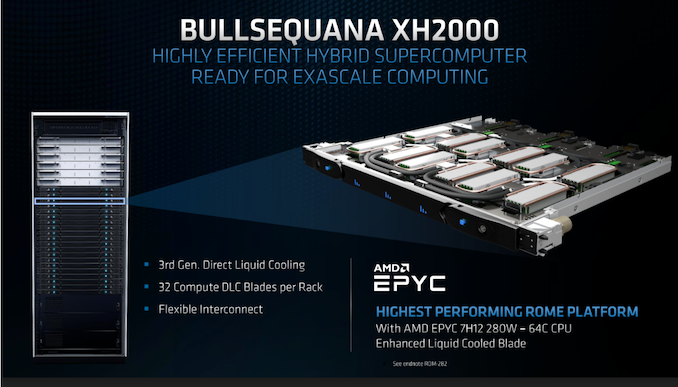AMD’s New 280W 64-Core Rome CPU: The EPYC 7H12
by Dr. Ian Cutress on September 18, 2019 9:15 AM EST
If there’s something that gets everyone excited, it is more performance. On the Enterprise side, AMD has made big strides with its latest EPYC processor stack, featuring up to 64 cores per socket with 128 PCIe 4.0 lanes and 8-channel memory, featuring a very high performance per dollar in the marketplace. In order to coincide with the launch of the processor line-up in Europe today, AMD is unveiling a new chip to act as the new Halo product: the EPYC 7H12.
The new processor features a higher base frequency and a higher boost frequency that the previous top-of-the-line processor, the EPYC 7742. The new EPYC 7H12 has a rated TDP of 280W, and as a result the chip is being marketed for server environments that offer liquid cooled solutions only. AMD is very specific about this, especially in the market for which this CPU is aimed at. One of AMD’s main partners, Atos, is set to offer an 1U solution featuring eight of these CPUs, all liquid cooled.
| AMD EPYC 7002 Processors (2P) | ||||||
| Cores Threads |
Frequency (GHz) | L3* | TDP | Price | ||
| Base | Max | |||||
| EPYC 7H12 | 64 / 128 | 2.60 | 3.30 | 256 MB | 280 W | ? |
| EPYC 7742 | 64 / 128 | 2.25 | 3.40 | 256 MB | 225 W | $6950 |
| EPYC 7702 | 64 / 128 | 2.00 | 3.35 | 256 MB | 200 W | $6450 |
| EPYC 7642 | 48 / 96 | 2.30 | 3.20 | 256 MB | 225 W | $4775 |
| EPYC 7552 | 48 / 96 | 2.20 | 3.30 | 192 MB | 200 W | $4025 |
For a base frequency, the EPYC 7H12 will be set at 2.6 GHz, and a turbo frequency of 3.3 GHz. Compared to the EPYC 7742, that’s +350 MHz on base and -100 MHz on turbo, for an increase in +55W TDP. The higher TDP means the 7H12 is expected to have an all-core turbo a lot higher than the 7742. The EPYC 7H12 is socket compatible with all other Rome processors.
With this new CPU, AMD is clearly going after the high-performance compute market. The chip still affords the same specifications as the rest of the stack, such as the PCIe lanes, the memory support, and security features, should any other market be interested, but AMD expects this CPU to be installed in large HPC datacenters. AMD published raw LINPACK metrics with a performance uplift of the 7H12 over the 7742 at around 11%.
We asked AMD if this is a chip designed for specific partners who can enable liquid cooling servers, or for any OEM that wants it. AMD responded stating the latter – this chip will have general availability, but given the target market, they are pushing it only for liquid cooled HPC systems. AMD states they have other processors better suited to certain other fields, such as finance.
We expect AMD’s OEM partners to be evaluating the 7H12 for their system offerings, with further announcements in due course.
Related Reading
- AMD Rome Second Generation EPYC Review: 2x 64-core Benchmarked
- The AMD 2nd Gen EPYC "Rome" Launch Live Blog
- Lenovo Launches ThinkSystem SR635 & SR655 Servers with AMD’s EPYC ‘Rome’ CPUs
- AMD Zen 2 Microarchitecture Analysis: Ryzen 3000 and EPYC Rome











54 Comments
View All Comments
Zoolook13 - Friday, September 20, 2019 - link
In Sweden all the main cloud providers are building massive complexes and hooking them up to municipal district heating systems, selling the heat they create.Quite a few are also built in the north of Sweden where the outside temperature is below freezing for 6 months/year, cheap cooling and selling the heat combined with plenty of renewable energy equals great operating costs.
mikegrok - Friday, September 20, 2019 - link
When you buy a system that will go into a data center, you often price the machine that you are going to install at 3 to 5 years of it's operating cost.When paying for power in the data center, you usually get charged about triple, because for every kw of power consumed, it may take 2kw of power to chill the air to it's initial temperature. This is where the benefit of water cooling comes into play.
A water cooled CPU does not need the inlet water temperature to be the same as the air temperature. In fact, a water in temperature of 140F is often acceptable. Chilling water to 140F can be accomplished using radiators and pumps nearly anywhere in the world, without the need to "chill" the water below outside ambient temperature.
The above power reduction can drop the cost of running the CPU to 1/3, justifying installing a CPU and system that costs 3 times as much, because the budget for upkeep got moved to the hardware purchase price.
The building will probably have several water "chillers" available for water cooled CPUs.
Processors often have a target temperature to reach.
mikegrok - Friday, September 20, 2019 - link
The above power reduction can drop the cost of running the CPU to 1/3, justifying installing a CPU and system that costs nearly double, because the budget for upkeep got moved to the hardware purchase price.Ozymankos - Monday, September 23, 2019 - link
Finally we have 128 threads processors again on our ble planet GaiaLet us count:
65 nm-4 cores-Q6600
45 nm-Nehalem Intel -8 cores
32 nm-16 cores-Opteron from AMD
22 nm-32 cores-Zen from AMD
14 nm-64 cores-Epyc from AMD
10 nm-128 cores or Threads-Epyc again
7 nm-256 cores
bear in mind that is advertised as being the 7 nanometer process but it is in reality 10 nanometers